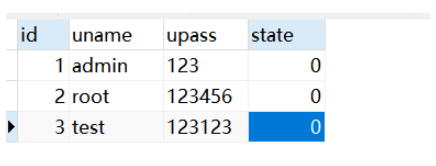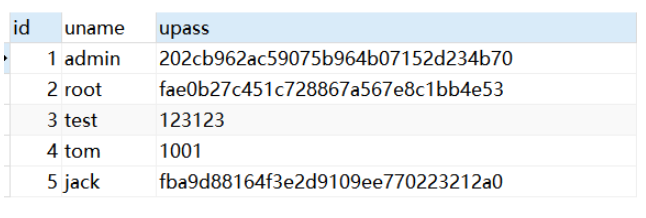How to use MD5 encryption in MySQL
What is MD5?
MD5 Message-Digest Agorithm (English: MD5 Message-Digest Agorithm), a widely used cryptographic hash function that can produce a 128-bit (16-byte) hash value (hash value) , used to ensure complete and consistent information transmission. MD5 was designed by American cryptographer Ronald LinnRivest and made public in 1992 to replace the MD4 algorithm. The program of this algorithm is specified in the RFC1321 standard. After 1996, it was confirmed that the algorithm has weaknesses and can be cracked. For data that requires high security, experts generally recommend using other algorithms, such as SHA-2. In 2004, it was confirmed that the MD5 algorithm cannot prevent collisions, so Not suitable for security authentication, such as SSL public key authentication or digital signatures.
MD5 First Experience

Prepare a simple user table in mysql for case operations.
Next, test various sql statements:
Normal insertion statement (password plain text):
-- 普通新增语句(明文密码) insert into user(uname,upass) values ('tom','1001');
Encrypt when inserting information**: **
-- 插入时使用MD5 算法加密 insert into user(uname,upass) values ('jack',MD5('1002'));
Query and view results:

Modify: Use the MD5 algorithm to modify the password of the account admin.
-- 将原密码换为MD5加密后的密码 update user set upass=MD5(upass) where id =1; -- 将原密码123456修改为 MD5加密后的密码(666) update user set upass=MD5('666') where id =2;
Result:

Encrypt all passwords:
-- 加密全部密码 update user set upass=MD5(upass)

Conditional query for verification:
-- 根据账号密码 查询对应账号信息 select * from user where uname='admin' and upass=MD5('123')

-- 测试 将密码修改为666 的账号信息 select * from user where uname='root' and upass=MD5('666')

The above is a simple encryption of some information in the mysql database through the MD5 algorithm. The specific knowledge needs to be sorted out.
Other methods in MySQL
(1) PASSWORD() function:
-- password() 函数加密 update userinfo set password =password('333') where id=6 -- 查询验证 select * from userinfo where password=password('333')
password(str) calculates and returns the encrypted password string from the original plaintext password str, When the parameter is null, null is returned. Password encryption is one-way and irreversible.
(2) ENCODE() function
ENCODE(str, pass_str) function is used to encode plain text strings and return binary strings after encoding.
Use pswd_str as password, encrypt str.
str: It is used to specify the plain text to be encoded
pass_str: It is used to specify the password string to plain text characters The string is encoded.
-- 字符串 select encode('hello','nice')

-- 字符串和数字 select encode('nihao666','nice')

(3) DECODE(crypt_str,pass_str)
Use pswd_str as the password, Decrypt the encrypted string crypt_str, crypt_str is the string returned by encode().
select DECODE('nihao666','nice')

-- 使用decode函数解密encode加密的字符串 select DECODE(ENCODE('nihao666','nice'),'nice');

The above is the detailed content of How to use MD5 encryption in MySQL. For more information, please follow other related articles on the PHP Chinese website!

Hot AI Tools

Undresser.AI Undress
AI-powered app for creating realistic nude photos

AI Clothes Remover
Online AI tool for removing clothes from photos.

Undress AI Tool
Undress images for free

Clothoff.io
AI clothes remover

AI Hentai Generator
Generate AI Hentai for free.

Hot Article

Hot Tools

Notepad++7.3.1
Easy-to-use and free code editor

SublimeText3 Chinese version
Chinese version, very easy to use

Zend Studio 13.0.1
Powerful PHP integrated development environment

Dreamweaver CS6
Visual web development tools

SublimeText3 Mac version
God-level code editing software (SublimeText3)

Hot Topics
 1381
1381
 52
52
 MySQL: Simple Concepts for Easy Learning
Apr 10, 2025 am 09:29 AM
MySQL: Simple Concepts for Easy Learning
Apr 10, 2025 am 09:29 AM
MySQL is an open source relational database management system. 1) Create database and tables: Use the CREATEDATABASE and CREATETABLE commands. 2) Basic operations: INSERT, UPDATE, DELETE and SELECT. 3) Advanced operations: JOIN, subquery and transaction processing. 4) Debugging skills: Check syntax, data type and permissions. 5) Optimization suggestions: Use indexes, avoid SELECT* and use transactions.
 How to open phpmyadmin
Apr 10, 2025 pm 10:51 PM
How to open phpmyadmin
Apr 10, 2025 pm 10:51 PM
You can open phpMyAdmin through the following steps: 1. Log in to the website control panel; 2. Find and click the phpMyAdmin icon; 3. Enter MySQL credentials; 4. Click "Login".
 How to create navicat premium
Apr 09, 2025 am 07:09 AM
How to create navicat premium
Apr 09, 2025 am 07:09 AM
Create a database using Navicat Premium: Connect to the database server and enter the connection parameters. Right-click on the server and select Create Database. Enter the name of the new database and the specified character set and collation. Connect to the new database and create the table in the Object Browser. Right-click on the table and select Insert Data to insert the data.
 MySQL: An Introduction to the World's Most Popular Database
Apr 12, 2025 am 12:18 AM
MySQL: An Introduction to the World's Most Popular Database
Apr 12, 2025 am 12:18 AM
MySQL is an open source relational database management system, mainly used to store and retrieve data quickly and reliably. Its working principle includes client requests, query resolution, execution of queries and return results. Examples of usage include creating tables, inserting and querying data, and advanced features such as JOIN operations. Common errors involve SQL syntax, data types, and permissions, and optimization suggestions include the use of indexes, optimized queries, and partitioning of tables.
 Why Use MySQL? Benefits and Advantages
Apr 12, 2025 am 12:17 AM
Why Use MySQL? Benefits and Advantages
Apr 12, 2025 am 12:17 AM
MySQL is chosen for its performance, reliability, ease of use, and community support. 1.MySQL provides efficient data storage and retrieval functions, supporting multiple data types and advanced query operations. 2. Adopt client-server architecture and multiple storage engines to support transaction and query optimization. 3. Easy to use, supports a variety of operating systems and programming languages. 4. Have strong community support and provide rich resources and solutions.
 How to create a new connection to mysql in navicat
Apr 09, 2025 am 07:21 AM
How to create a new connection to mysql in navicat
Apr 09, 2025 am 07:21 AM
You can create a new MySQL connection in Navicat by following the steps: Open the application and select New Connection (Ctrl N). Select "MySQL" as the connection type. Enter the hostname/IP address, port, username, and password. (Optional) Configure advanced options. Save the connection and enter the connection name.
 How to use single threaded redis
Apr 10, 2025 pm 07:12 PM
How to use single threaded redis
Apr 10, 2025 pm 07:12 PM
Redis uses a single threaded architecture to provide high performance, simplicity, and consistency. It utilizes I/O multiplexing, event loops, non-blocking I/O, and shared memory to improve concurrency, but with limitations of concurrency limitations, single point of failure, and unsuitable for write-intensive workloads.
 MySQL and SQL: Essential Skills for Developers
Apr 10, 2025 am 09:30 AM
MySQL and SQL: Essential Skills for Developers
Apr 10, 2025 am 09:30 AM
MySQL and SQL are essential skills for developers. 1.MySQL is an open source relational database management system, and SQL is the standard language used to manage and operate databases. 2.MySQL supports multiple storage engines through efficient data storage and retrieval functions, and SQL completes complex data operations through simple statements. 3. Examples of usage include basic queries and advanced queries, such as filtering and sorting by condition. 4. Common errors include syntax errors and performance issues, which can be optimized by checking SQL statements and using EXPLAIN commands. 5. Performance optimization techniques include using indexes, avoiding full table scanning, optimizing JOIN operations and improving code readability.




